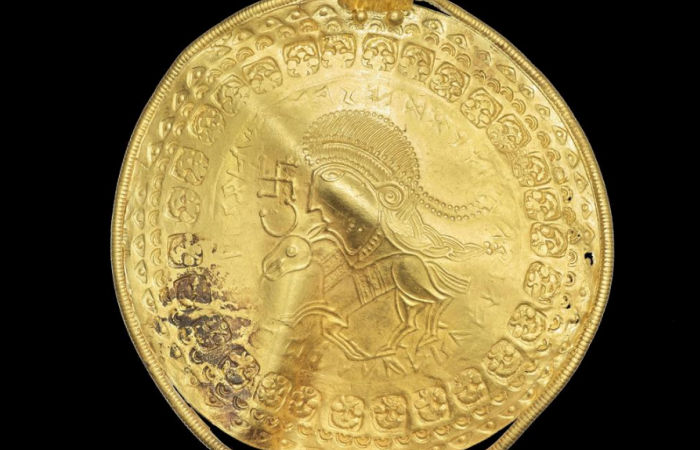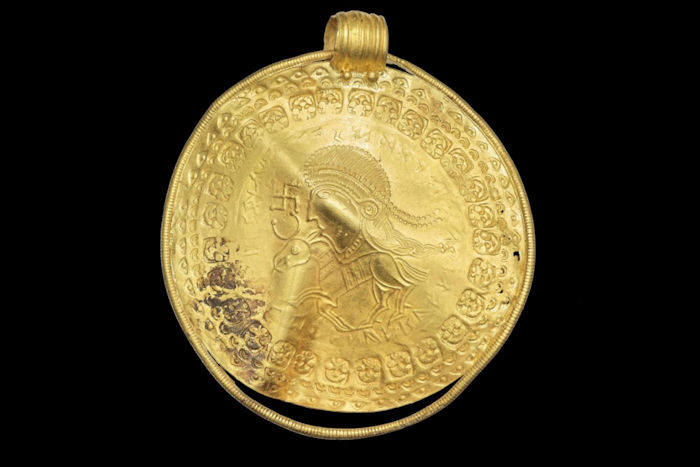Jan Bartek – MessageToEagle.com – With 800 grams of real gold, the Vindelev treasure is one of the largest treasures unearthed recently. Found by two old friends and amateur archaeologists in a field in Jelling, Denmark, in 2020, the ancient artifacts now reveal secrets from the past and re-write ancient history!
The discovery is of the utmost importance because we now have evidence of Norse mythology 150 years earlier than previously – already at the beginning of the 4th century.
The oldest example we have so far of humans writing the word ‘Odin’. This suggests that the Nordic god was already a central part of the cult in the fourth century. Credit Photo: Arnold Mikkelsen, National Museum, Denmark
The Vindelev treasure was discovered where there had been a farm consisting of several longhouses and fences. For this reason, it is assumed the treasure belonged to a local chieftain or perhaps king, who buried it inside or near the house. In the 4th and 5th centuries, wealthy individuals wore gold medallions to show their status and wealth.
Studies of two 1,600-year-old gold medallions that are part of the treasure led to the discovery of very long runic inscriptions in which the name of the supreme god of the Aesir, Odin, appears.
Runologist and script researcher Lisbeth Imer and linguist Krister Vasshus from the National Museum in Denmark made this incredible discovery.
On the gold medallion, there is also a portrait of an unknown king or great man, who may have had the (nick)name “Jaga” or “Jagaz,” and it is precisely here that Odin’s name comes into play. Next to him, it says that he is “Odin’s man.”
“But who is this Odin’s husband? It must be the hunter who may have had the (call) name Jaga.
And who is the hunter or Jaga?
We know that Saxo calls the images on bracteates kings and that the bracteates imitate Roman imperial depictions.
Therefore, we must interpret the inscription as a presentation of the person depicted, the king.
The king is referred to as Odin’s husband, which shows his divine legitimacy, and perhaps also tells us that he is the supreme cult leader of society,” the science team explains in a press statement.
The inscription runs in a circle around the motif of the bracteate, which shows a king’s face seen in profile and with a nice hairstyle. In front of the face are a swastika and a semicircle that perhaps symbolizes the sun and the moon.
Under its face stands a four-legged animal, presumably a horse, with a marked harness and something sticking out of its mouth. The horse’s ear points towards the king’s open mouth. “The runic inscription has been the most difficult to interpret in my 20 years as a runologist at the National Museum. Still, the discovery is also absolutely fantastic,” says Lisbeth Imer.
The other gold medallion also has a long inscription that appears to have been copied on one of the other pendants. However, it is poorly executed reproduction.
The motifs of the bracteates were produced in matrices (stamps) of bronze, which were stamped into plates of gold. That way, you could make several bracts with the same motif. The inscription runs from right to left on the bracteate and was originally written from left to right in the matrix. Credit Photo: Arnold Mikkelsen, National Museum, Denmark
This pendant also shows a king seen from the side with a nice hairstyle above a horse with its ear pointing towards the king’s mouth.
In front of the face are the same symbols as on the first bracteate and three dots which perhaps symbolize the stars.
The inscription runs in a circle around the motif, and some of the characters are clearly runes, while others just look like or are blurred long lines.
It seems that whoever made the inscription in the matrix did not fully understand the text but copied the appearance of the characters as best he could.
The long inscription on another bracteate from the Vindelev treasure is a poorly executed copy of the beautifully executed one. Credit Photo: Arnold Mikkelsen, The National Museum of Denmark
The meaning of the inscription has clearly been the same as on the first bracteate, but there is one detail that means that it cannot be interpreted as a direct copy of the first:
The name Odin is spelled differently, and it also seems that the scribe has swapped two runes. Where he actually wanted to write woþanas , he has written þowa(nas) .
The two runes, representing the sounds /w/ and /þ/, are almost identical, making them easy to confuse – especially when the runes are only 2mm high.
This means a third inscription once existed with the same content as the two bracts. It must have been a very important and perhaps sacred text that many have been interested in copying.
There could be many good reasons for being fulfilled by Odin’s power and magical abilities as a king.
The solution to an old riddle
The long and complete inscription on the bracteate from Vindelev is the key to several unsolved riddles in the Iron Age.
It shows that Odin is a very old deity, already known in the 4th century and that the images of the bracteates should rather be interpreted as kings than as the god himself.
It is also the key to understanding how illegible bracteate inscriptions originally made sense.
The medallions are dated to the fourth century and are thus the oldest examples of the god Odin’s name in the world – at least for now.
Two almost identical bracteates, made with the same stamp. But one has been found in Vindelev in Jutland, the other at Bolbro on Funen. Credit: Photo: Arnold Mikkelsen, The National Museum of Denmark
The oldest inscription so far in which the god Odin appears is from the southern German area.
At a large burial ground near Nordendorf, the god’s name was found scratched on the back of a suit buckle dating to the second half of the 5th century.
Runes played an essential part in the lives of the Vikings. Unfortunately, there are few remains of runic writing on paper from the Viking era. Nevertheless, thousands of stones with runic inscriptions have been found where Vikings lived.
In Denmark, Odin’s name is represented on a piece of a human skull from Ribe. Here, Odin is invoked as one of three gods who must help the amulet’s owner from illness.
A funny detail is that the bracteate with the poorly executed text from Vindelev has a stamp-identical twin from Bolbro on the outskirts of Odense, made with the same die.
The Bolbro bracteate was found in 1852 and has since been in the National Museum’s collections.
There has thus been an ancient Odin inscription in the National Museum’s exhibitions for the past 170 years – but no one knew that until the Vindelev treasure was found.
Lisbeth M. Imer and Krister SK Vasshus publish a scientific article about the runic bracteates from Vindelev in the international journal NOWELE (North-Western European Language Evolution), which will be published in April-May 2023.
The Vindelev treasure can be seen in the National Museum’s Great Dane exhibition, ‘The hunt for Denmark’s history’ for the rest of 2023. The Bolbro bracteate is part of the permanent exhibition at the National Museum.
Written by Jan Bartek – MessageToEagle.com – AncientPages.com Staff Writer








